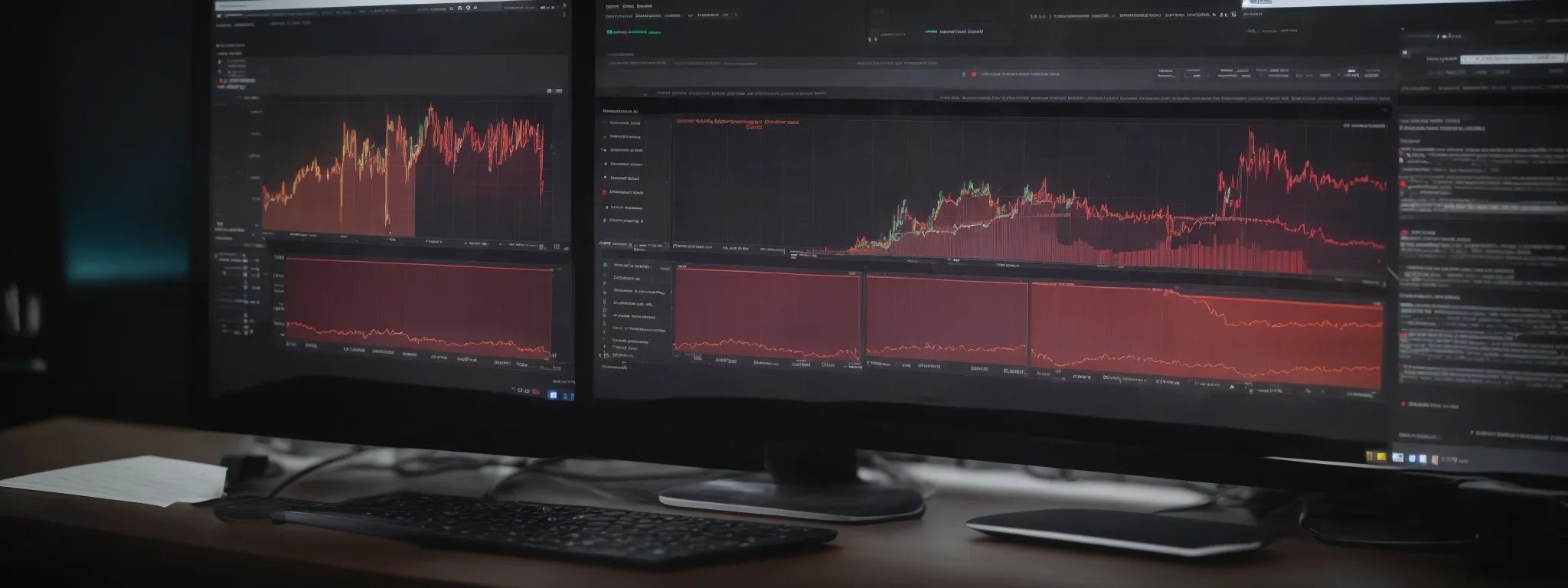Choosing the Best: A Guide to Conversion Rate Optimization
Mastering Conversion Rate Optimization: Your Ultimate CRO Guide Conversion rate optimization (CRO) goes beyond mere guesswork, commanding a strategic approach to enhancing the performance of your ecommerce […]
Mastering Conversion Rate Optimization: Your Ultimate CRO Guide
Conversion rate optimization (CRO) goes beyond mere guesswork, commanding a strategic approach to enhancing the performance of your ecommerce site.
By scrutinizing your current conversion rates and understanding the multidimensional elements at play, your digital marketing efforts can transform site visitors into customers more effectively.
Mastering CRO involves leveraging sophisticated tools and rigorous user testing to refine every touchpoint of the customer journey.
As you embark on this detailed guide, each section will unveil actionable insights and best practices to elevate your website conversion rate.
Keep reading to uncover the pivotal strides that will empower your company to optimize conversion rates like never before.
Key Takeaways
- Conversion Rate Optimization Is Central to Turning Site Visitors Into Loyal Customers
- Detailed Analysis and Tailored Strategies Using Platforms Like LinkGraph Can Significantly Improve Conversion Rates
- Implementing Clear Goals and Measurable Objectives Is Fundamental for Successful CRO Efforts
- A/B Testing and Heatmap Analysis Are Crucial Tools for Understanding and Enhancing User Engagement
- Case Studies on Successful CRO Campaigns Highlight the Importance of Aligning User Expectations With Website Functionality
Understanding the Fundamentals of CRO

In the digital marketing realm, the term ‘Conversion Rate Optimization’ (CRO) is pivotal, meriting thorough exploration by any entity invested in online commerce.
CRO demystifies the pathway between visitor interaction and the ultimate fulfillment of a conversion goal, whether it involves adding a product to a cart or signing up for a newsletter.
It stands at the crossroads of website performance metrics and user experience, aiming to catapult website conversion rates to new heights.
This concept is not only integral for accelerating commercial success but is also instrumental in fortifying the alignment between consumer expectations and digital presence.
Navigation through this intricate landscape requires a nuanced comprehension of the methodologies that Optimize Conversion Rates, an endeavor where tools like LinkGraph and SearchAtlas SEO software become indispensable allies.
Defining Conversion Rate Optimization in Simple Terms
Converting a website visitor into a customer is the crux of Conversion Rate Optimization (CRO), a systematic process that enhances the effectiveness of a site to escalate the percentage of users who complete a desired action. This journey from visitor to customer is scrutinized and optimized, offering tangible improvements in performance indicators like sales, leads, or subscriptions.
At its heart, CRO employs data-driven techniques and user feedback to refine and tweak the digital ecosystem, ensuring that every aspect of the user’s experience is catered to encourage the completion of the site’s conversion goals. With its focus on the user, CRO seeks to understand the audience’s behavior and eliminate barriers that prevent them from engaging as anticipated.
The Significance of CRO for Online Businesses
For online ventures, the gravity of Conversion Rate Optimization resides in its power to transform passive site visitors into active participants and, ultimately, into loyal customers. By implementing CRO, businesses unlock the potential for increased revenue without necessarily driving more traffic, instead enhancing the profitability of existing visitors.
Conversion Rate Optimization also magnifies the resonance of a company’s marketing efforts, ensuring that the user journey aligns seamlessly with the company’s value proposition. A fortified digital footprint marked by robust CRO strategies bolsters trust and conversion confidence among consumers, yielding a competitive edge in the bustling digital marketplace.
Analyzing Your Current Conversion Rate

Embarking on the journey of Conversion Rate Optimization begins with a critical assessment of the current effectiveness of your digital marketing strategy.
An analytical approach to understanding how often visitors engage in the desired manner provides valuable insight into the efficacy of your website’s conversion paths.
Mastery of Conversion Rate Optimization is contingent upon the ability to scrutinize these facets and recalibrate methodologies to finesse the user experience.
It is essential to not only quantify your conversion rate but also to dissect and comprehend the digital avenues through which conversions are cultivated.
Step-by-Step Process to Calculate Your Conversion Rate
A precise analysis of conversion rate begins with the calculation derived from dividing the number of conversions by the total number of visitors, then multiplying the result by 100 to obtain a percentage. This metric offers a baseline to compare against industry benchmarks or previous performance, setting the stage for Strategic Optimization Interventions provided by platforms such as LinkGraph.
For an even more granular view, businesses can segment conversion rate calculations by distinct visitor demographics or behaviors, allowing for targeted insights about specific audience segments. Having access to comprehensive tools like SearchAtlas SEO software amplifies the effectiveness of such analyses, enabling companies to shape their digital marketing strategies with precision and insight.
Identifying Your Website’s Conversion Paths
Charting the intricacies of a website’s conversion paths is a vital step in CRO, as it unveils specific routes that users take toward conversion. Every point of interaction, from the initial landing page to the intricacies of checkout processes, must be mapped to understand where optimization can have the most profound impact.
With analytical precision, businesses should harness platforms such as LinkGraph to meticulously track user navigation, identifying patterns that indicate successful pathways as well as areas where visitors veer off course. This insight provides a foundation upon which a robust, data-based CRO strategy can be constructed, targeting enhancements that streamline and simplify the journey to conversion.
Key Elements That Influence Conversion Rates

The success of Conversion Rate Optimization pivots on the refinement of numerous web elements, where each facet plays a critical role in guiding a prospect through to conversion.
Website design and the checkout process stand as two pillars in this endeavor, profoundly impacting how users perceive and interact with an online business platform.
Optimizing the aesthetic and functional aspects of a website catalyzes a better user experience, while a seamless checkout process streamlines the path to purchase, both increasingly critical in a digital ecosystem where user expectations and behaviors are ever-evolving.
Optimizing Web Design for Better User Experience
Web design optimization plays a crucial role in Enhancing User Experience, often serving as the determinative factor in whether a site visitor becomes a consumer. A cohesive, intuitive design that is responsive across devices invites deeper engagement and can significantly reduce bounce rate, which is central to propelling conversion rates upward.
Critical to the achievement of a better digital experience is the strategic implementation of elements like a clear value proposition and a compelling product page. These design elements must resonate with the target audience, fostering trust and simplifying the user’s decision-making process, thus nudging them further down the customer journey toward conversion.
Streamlining the Checkout Process for Higher Conversions
Streamlining the checkout process is a critical factor in boosting conversion rates. By reducing the number of steps to purchase and eliminating any unnecessary complexity, businesses can ensure a swift and satisfying transactional experience for the user.
The implementation of clear navigational cues and assurances of security, such as SSL certificates, builds consumer confidence during checkout. These measures directly facilitate a frictionless flow toward transaction completion, paving the way for a higher conversion rate:
- Minimize the number of fields required for checkout, focusing solely on essential information.
- Incorporate multiple payment options to cater to varied customer preferences.
- Use progress indicators to inform users of their checkout stage, enhancing transparency.
Developing a Robust CRO Strategy

In the upper echelons of digital marketing, fine-tuning a Conversion Rate Optimization strategy requires a firm grasp of the endgame.
Successful CRO maneuvers hinge on the clarity and precision of objectives, aligning the tactical aspects of optimization with clearly outlined goals.
Before delving into the data-laden landscape of CRO, businesses must eschew ambiguity by setting measurable, attainable conversion objectives.
This clarity forms the backbone for prioritizing areas within their website to focus their testing efforts, establishing a bedrock for data-driven decisions that ultimately drive conversion success.
Setting Clear and Measurable CRO Objectives
Embarking upon Conversion Rate Optimization demands quantifiable aspirations, with clear and measurable objectives that act as navigational beacons. The setting of achievable targets, such as enhancing sign-ups by 25% or growing the completion rate of a critical user action by 15%, provides a concrete base for the incremental, tactical deployment of strategies and resources.
Organizations must establish a range of focused goals that encompass various facets of performance to fully leverage the capabilities of optimization tools, like LinkGraph’s Suite of Services. Each goal necessitates its own tailored set of analytics metrics, which will empower marketers to dissect data with precision and intention, ultimately steering conversion improvement actions:
| Conversion Goal | Specific Objective | Intended Outcome |
|---|---|---|
| Email Newsletter Sign-ups | Increase by 25% | Expand customer base and engagement |
| Product Page Conversions | Improve by 20% | Drive sales and revenue |
| User Account Creations | Boost by 30% | Enhance user retention and customization experiences |
Prioritizing Areas of Your Website for Testing
In determining where to concentrate efforts for CRO testing, attention is often drawn first to the pages with the highest traffic but lowest conversion rates. These segments of a website are ripe for optimization as they represent key opportunities where tweaks and enhancements can lead to significant improvements in performance.
For a comprehensive approach, marketers may leverage the sophisticated analytics capabilities of tools like SearchAtlas SEO software, pinpointing areas where user engagement wanes. Identifying and addressing these critical junctures where potential customers lose interest ensures a strategic and focused optimization that aligns with overarching business objectives.
Tools and Techniques for Effective CRO

Peeling back the layers of conversion rate optimization reveals a myriad of tools and techniques quintessential for finessing the digital user experience.
Among the arsenal available for discerning digital marketers, A/B testing and heatmap analysis stand out for their adept capacity to inject empirical insights into strategic decision-making processes.
A/B testing serves as a crucible for hypothesis validation, meticulously comparing variants of a web element to decipher the most effective version for fostering conversions.
Concurrently, heatmaps provide a vivid representation of user interaction, offering an intuitive visual narrative of areas that capture attention or may inadvertently hinder the user journey.
Together, these approaches underpin the transformative power of informed CRO tactics, ensuring that each alteration is calibrated to the nuances of user behavior and engagement.
Leveraging a/B Testing for Data-Driven Decisions
Leveraging a/B testing is a cornerstone of Data-Driven Decision-Making, serving as a compass to guide digital marketers towards optimization strategies that resonate most effectively with their audience. By isolating variables and testing variant ‘A’ against variant ‘B’, companies can distill actionable insights, fostering an environment of continuous improvement tailored to user preferences.
This rigorous approach not only confirms which elements of a web page are most conducive to user engagement but also strengthens marketing initiatives by anchoring them in empirical evidence. A/B testing harnesses the potential of real-world data, mitigating the subjective nature of design and content choices:
- Evaluate the impact of color schemes on user engagement and conversion.
- Determine the most compelling call-to-action wording to inspire consumer action.
- Test different layouts for product pages to maximize visual appeal and functionality.
With the precise application of testing results, businesses can adjust their digital touchpoints, ensuring that every tweak is a strategic step toward enhancing the user experience and boosting conversion rates. This methodical process paves the way for optimized user journeys, decreasing bounce rates, and heightening the probability of a website fulfilling its conversion goals.
Employing Heatmaps to Understand User Behavior
Heatmaps represent a powerful visualization tool that captures and displays user behavior on a website through color-coded maps. They reveal hot spots where activity is concentrated and cooler areas indicating less interaction, providing marketers with a comprehensive look at where users click, scroll, and linger.
By integrating heatmaps into their CRO toolkit, professionals can dissect the nuances of user engagement, pinpointing areas ripe for improvement. This direct insight enables businesses to make user-centered design choices, ensuring each element of the website is fine-tuned to facilitate a seamless and converting user journey.
Learning From CRO Case Studies

In the sphere of digital marketing, demystifying the secrets behind high-performing Conversion Rate Optimization (CRO) campaigns is akin to unlocking a chest of strategic treasures.
Resounding success in the digital marketplace often stems from a meticulously crafted CRO campaign, underscored by an acute understanding of the customer journey.
As professionals endeavor to infuse their digital marketing initiatives with these proven tactics, analyzing successful CRO case studies becomes a pivotal exercise.
These documented successes serve as a beacon, guiding marketers to discern which CRO methodologies resonate the most and why they propel conversion metrics skyward.
By distilling the essence of these triumphs and integrating the learnings, businesses are empowered to recalibrate their CRO approaches, positioning themselves to reap similar success and foster user journeys that culminate in conversion.
Analyzing Successful CRO Campaigns and Why They Worked
An incisive analysis of successful Conversion Rate Optimization campaigns reveals a shared cornerstone: the meticulous alignment of user expectations with website functionality. These case studies often showcase how Strategic Alterations, guided by data from tools like LinkGraph and SearchAtlas SEO software, can amplify user engagement and facilitate a seamless transition from browsing to action-taking.
One emblematic attribute of these victorious campaigns is the application of targeted improvements across various website components, including persuasive copy, intuitive design, and streamlined navigation. By observing consumer interactions and responding with precision, digital marketers employ substantive modifications that directly address user behavior, effectively bolstering conversion rates and setting a precedent for best practices in CRO.
Applying Lessons From Case Studies to Your CRO Efforts
Incorporating the insights gleaned from CRO case studies, companies cultivate a strategic perspective that informs future optimization efforts. Recognizing patterns in these success stories allows businesses to emulate effective strategies, such as unique value propositions or sophisticated personalization techniques, and apply them within their own conversion optimization framework.
By critically evaluating these narratives, entities can identify the underlying principles of effective CRO—such as simplifying user pathways or reinforcing trust signals—that have universally improved website performance. Armed with this knowledge, a company can adopt and adapt these strategies, thereby enhancing their own digital marketing proficiency and elevating website conversion rates.
Conclusion
Mastering Conversion Rate Optimization (CRO) is a crucial component for online success, serving as a linchpin for turning passive website visitors into engaged customers and boosting revenue.
The core of CRO lies in understanding user behavior to eliminate barriers that prevent conversions, while also streamlining the user’s journey towards fulfilling the site’s conversion goals.
A successful CRO strategy involves setting clear objectives, meticulously analyzing current conversion rates, and identifying the most impactful pathways for improvement.
By optimizing web design and checkout processes, along with employing tools like A/B testing and heatmaps, businesses can create a data-driven feedback loop to enhance user experiences and increase conversion rates.
Analyzing and applying lessons from successful CRO case studies enables businesses to implement proven tactics to their advantage.
Ultimately, the art of CRO is an iterative process of testing, learning, and refining, with the end goal of cultivating a more profitable and user-centric online presence.














































































